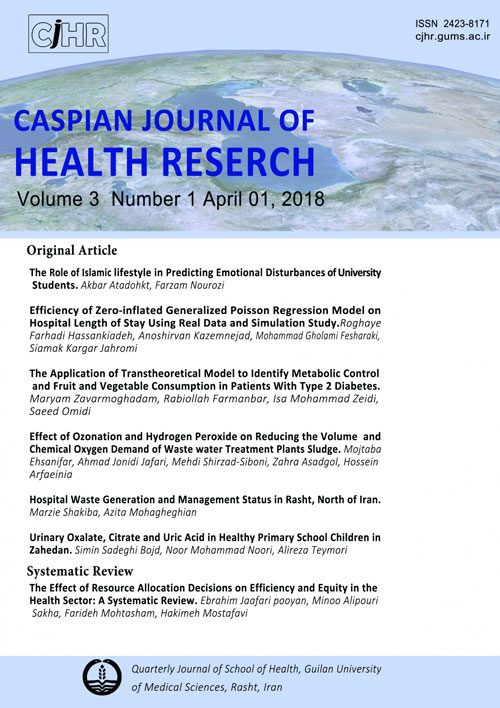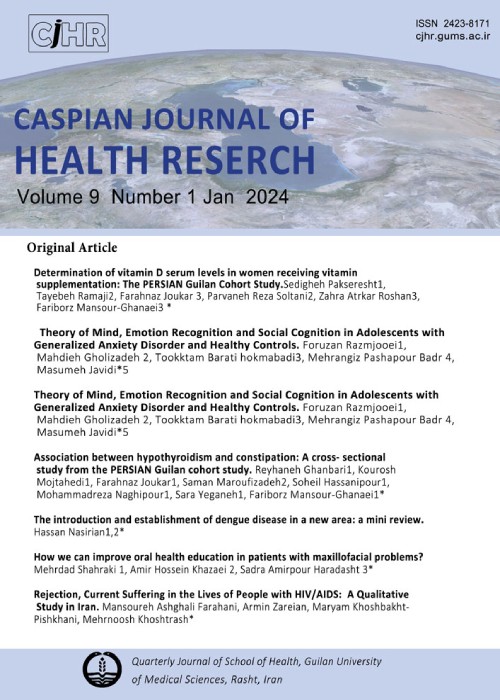فهرست مطالب

Caspian Journal of Health Research
Volume:3 Issue: 1, Mar 2018
- تاریخ انتشار: 1397/02/30
- تعداد عناوین: 7
-
Pages 1-4BackgroundGiven the importance of students mental health, this study aimed to investigate the role of Islamic lifestyle (ILST) in predicting emotional disturbances of university students.MethodsThis cross-sectional study was conducted on students at University of Mohaghegh Ardabili during 2013 to 2014. A total sample of 200 students were selected by convenience sampling method. Participants completed ILST questionnaire and depression anxiety stress scale (DASS-21). Data were analyzed using correlation coefficient and multivariate linear regression method.ResultsA total of 173 students including 96 men and 80 women were participated. ILST was inversely correlated with depression (r=-0.52, P-valueConclusionThis study showed significant association between Islamic lifestyle and mental health. Therefore more attention should be paid to students tendencies to Islamic lifestyle.Keywords: Anxiety, Depression, Emotional Disturbance, Lifestyle, Students
-
Pages 5-9BackgroundAn important feature of Poisson distribution is the equality of mean and variance. However, additional zeroes in the data may cause over-dispersion in most cases, in which zero-inflated models are recommended. In this study, we aimed to evaluate the efficacy of zero-inflated models to predict hospital length of stay using real data and simulated study.MethodsThis study was conducted on patients admitted at Shariati hospital, Tehran, Iran. Zero inflated Poisson (ZIP), zero inflated negative binomials (ZINB) and zero inflated generalized Poisson (ZIGP) models were fitted on patients length of stay. The fitted models were compared using the Akaike information criterion (AIC). The simulated data was generated using a model with the lowest AIC. Different models were then compared using the AIC. Data analysis was performed in R statistical software.ResultsThe results of both real data and simulation study showed lower AIC for ZIGP model compared to ZIP and ZINB model.ConclusionGiven the high dispersion and Zero Inflation in hospital length of stay, the zero-inflated generalized Poisson regression model is the most suitable model to predict determinants of LOS.Keywords: Computer Simulation, Hospital, Length of Stay, Poisson Distribution
-
Pages 10-14BackgroundDiabetes is a major and costly health problem for patients and health care system, and requires a change in patients lifestyle. The present study aimed to determine the factors predicting fruit and vegetable consumption and HbA1C control in diabetic patients based on the transtheoretical model.MethodsIn this cross-sectional study, 98 women with diabetes in Qazvin city were recruited. Information regarding demographic characteristic, transtheoretical model questionnaire, HbA1C level and weekly consumption of fruits and vegetables were completed for each participant. The variables were compared using analysis of variance.ResultsThe mean HbA1C level was 7.87 and the amount of consumed fruit and vegetables was 2.58 units per day. Of all participants, 77.55% were in the pre-action stage and 22.45% in the action stage of consumption of five portions of fruit and vegetables a day. Diabetic women in action stages of change had significantly higher mean score of self-efficacy (P-value= 0.046) and process of change (P-value= 0.023) compared to women in pre-action stage of change.ConclusionThe results showed that stage of change contributed to the behavior of fruits and vegetables consumption, patients self-efficacy and process of change. This study recommends applying transtheoritical model in intervention programs for taking fruits and vegetables in diabetic patients.Keywords: Diabetes, Glycated Hemoglobin A, Lifestyle, Theoretical model
-
Pages 15-19BackgroundOzonation decays solids and accelerates their consolidation due to strong oxidation capability; hence, decreasing the problems and expenses of equipment and operating the sludge digestion and disposal. In this study, we aimed to investigate the effect of separate and combined effects of ozone and hydrogen peroxide in reducing contamination volume.MethodsSludge ozonation was conducted with concentrations of 0.0557 to 0.5573mg O3/mgTSS5573 from 5 to 50 min. Total suspended solids (TSS), volatile solids (VS), chemical oxygen demand (COD) parameters, soluble COD, and the sludge settleability were investigated before and after the process.ResultsThe results demonstrated that after 50 min of ozonation and injection of mgO3/mg TSS 0.3901 ozone, sludge volume reduction reached 42%. Furthermore, after 50 minutes of ozonation, TSS and VS with a 43% and 48% reduction, reached to 4261mg/l and 3193mg/l, respectively. Total COD after 35 min of ozonation decreased 39% from 12524mg/l to 7639mg/l. Also injection of 6ml of hydrogen peroxide (30%) leading to a reduction in TSS and VS by 64 and 65%, respectively, and injection of 4ml of it, resulting in a 58% reduction in COD and 75% in the volume of sedimented sludge. The effect of the combination of ozone and hydrogen peroxide resulted in the reduction of only 10% of sedimented sludge volume and also reduced removal of COD by 42%.ConclusionAccording to the results, ozone and hydrogen peroxide injection to sludge, decrease sludge volume, improve in sedimentation and reduce the pollution load at the level of standardKeywords: Hydrogen Peroxide, Sewage, Waste Water
-
Pages 20-23BackgroundWe aimed to evaluate the quantity of waste generation and quality of hospital waste management among all hospitals in Rasht, North of Iran.MethodsIn this hospital-based cross sectional study all 16 hospitals in city of Rasht were evaluated. The questionnaire included information about general characteristics of hospital, daily amount of hospital waste, and the structure of waste management. The mean generation of hospital wastes were calculated as per capita rate measured in kg per bed per day for different kinds of wastes.ResultsThe mean weight of total hospital waste was 4.46 kg/bed/day (95%CI: 3.32-5.59) including 2.76 kg/bed/day (95%CI: 2.02-3.51) general wastes and 1.69 kg/bed/day (95%CI: 1.14-2.24) hazardous wastes. The hazardous wastes comprised 36% of total hospital wastes. All hospital adhered to safe management of wastes including segregation (100%), equipment with treatment technologies (100%), having suitable temporal storage place (100%), and storage for less than 24 hours in temporal place (69%).ConclusionThe percentage of hazardous hospital waste was higher than estimated percentage by world health organization. Regarding to observing safe management of wastes in all hospitals, there is a need to give more attention to sustainable development of hospital wastes in the acquisition and use of resources.Keywords: Hospital, Iran, Rasht, Waste Generation, Waste Management
-
Pages 24-27BackgroundUrolithiasis in children is associated with metabolic disorders. The most important metabolic disorders are hypercalciuria, hyperoxaluria, hypocitraturia, cysitinuria and hyperuricosuria. This study aimed to evaluate the level of urinary solutes in healthy primary school children in Zahedan, Iran.MethodsThis study was carried out on primary school-aged children. A total of 1800 samples were randomly selected using multistage random sampling method. Morning urine samples of children were taken and sent to the laboratory. Urine creatinine was measured by colorimetric device without removing proteins with BT3000 and photometer analyzer based on Jaffe method. Oxalate, uric acid, and citrate were measured using Pars test kits with photometric method. Weight and height were measured using standard protocols. Body mass index (BMI) was calculated as the ratio of weight in kg to height in square of meter. The ratio of oxalate, citrate, and uric acid to creatinine were then measured based on age, sex, and BMI categories.ResultsOf total, 1157 schoolchildren were participated in the study. The mean age of participants was 9 years (Range: 7-13 years) including 433 males (37.4%) and 724 females (62.6%).The mean level of Oxalate, citrate and uric acid to creatinine were estimated to be 0.02 ± 0.01, 2.98 ± 2.39 and 3.22 ±0.59, respectively. The prevalence of hpeyroxaluria, hypocitraturia and hyperuricosuria was 25.3%, 20.3% and 34.6%, respectively. There was significant relationship between age and ethnicity with urinary metabolic disorder.ConclusionIn this study, a high prevalence of urinary metabolic disorders were identified in school-aged children. The screening program of urinary solute for early detection of urinary metabolic disorder and kidney stones is recommended.Keywords: Citrates, Oxalates, Schools, Uric Acid
-
Pages 28-34BackgroundThe ultimate goal of health systems is creating a healthy community through the efficient and equitable provision of health services. The proportion of equity and efficiency of health systems indicates the quality of their practice. This systematic review aims to seek evidence that show any effect of resource allocation decisions on efficiency and equity in health worldwide.MethodsFive databases including PubMed, Scopus, Ovid, ProQuest, and EBSCOHOST were searched from 1992 to 2014. Based on the inclusion criteria, 527 papers were identified, of which 11 were assessed and analyzed.ResultsThe 11 included studies have been conducted in different countries including USA, North Africa, Greece, China, Australia, Taiwan, and South Africa. The main methods for resource allocation included: linear programming, Markov model, cost-effectiveness analysis, per capita resource allocation, modelling the resource allocation.ConclusionLinear and mathematical programming methods, and economic models such as Markov models can lead to equity and efficiency to some extent. These models take into account the details of treatment methods, the population under treatment, and costs of health services.Keywords: Efficiency, Health Equity, Health System, Resource Allocation, Systematic Review


